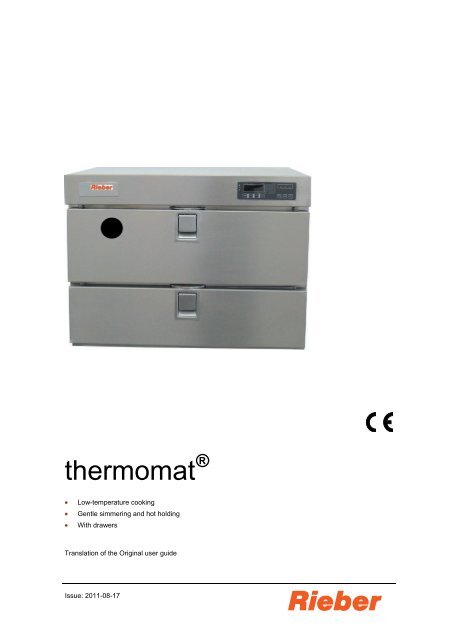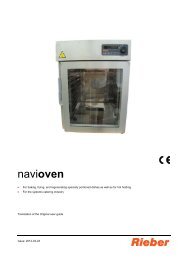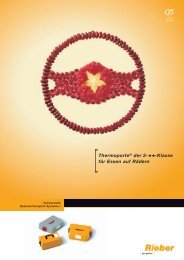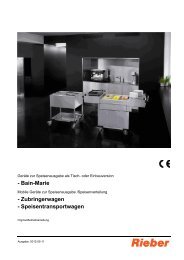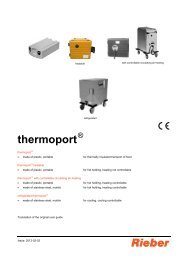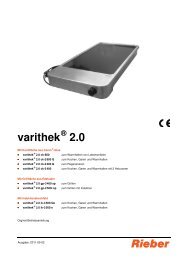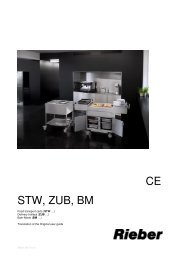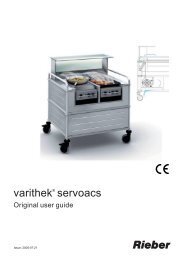Contents - Rieber GmbH & Co. KG
Contents - Rieber GmbH & Co. KG
Contents - Rieber GmbH & Co. KG
Create successful ePaper yourself
Turn your PDF publications into a flip-book with our unique Google optimized e-Paper software.
thermomat<br />
®<br />
• Low-temperature cooking<br />
• Gentle simmering and hot holding<br />
• With drawers<br />
Translation of the Original user guide<br />
Issue: 2011-08-17
<strong><strong>Co</strong>ntents</strong><br />
<strong><strong>Co</strong>ntents</strong><br />
1 Revision index ................................................................................................................................................. 3<br />
2 Important information ..................................................................................................................................... 3<br />
2.1 Use of this guide ................................................................................................................................................... 3<br />
2.2 Representation conventions in the text................................................................................................................. 4<br />
2.3 Structure of safety instructions.............................................................................................................................. 4<br />
3 Description of appliance................................................................................................................................. 5<br />
3.1 Explanations.......................................................................................................................................................... 5<br />
3.2 <strong>Co</strong>ntrol panel......................................................................................................................................................... 6<br />
3.3 Technical Details................................................................................................................................................... 7<br />
3.4 Accessories........................................................................................................................................................... 7<br />
4 Purpose ............................................................................................................................................................ 8<br />
5 General safety instructions ............................................................................................................................ 8<br />
5.1 General behaviour................................................................................................................................................. 8<br />
5.2 On use of electrical appliances ............................................................................................................................. 8<br />
5.3 Operator's duties ................................................................................................................................................. 10<br />
5.4 Personnel qualification........................................................................................................................................ 10<br />
5.5 Provide protective equipment for personnel ....................................................................................................... 11<br />
5.6 Appliance-specific safety instructions ................................................................................................................. 11<br />
5.7 Information about regulations to be followed ...................................................................................................... 12<br />
5.8 Instructions on behaviour in an emergency ........................................................................................................ 12<br />
6 Before first use .............................................................................................................................................. 13<br />
6.1 Transport............................................................................................................................................................. 13<br />
6.2 <strong>Co</strong>mmissioning / recommissioning ..................................................................................................................... 13<br />
7 Use.................................................................................................................................................................. 15<br />
7.1 Safety instructions on use................................................................................................................................... 15<br />
7.2 Instructions on use .............................................................................................................................................. 16<br />
7.3 Setting up and starting the core temperature function........................................................................................ 16<br />
7.4 Setting up and starting the time function ............................................................................................................ 17<br />
7.5 Setting up and starting the chamber temperature function................................................................................. 18<br />
8 Cleaning, maintenance and care.................................................................................................................. 19<br />
8.1 Safety information relating to cleaning, maintenance and care.......................................................................... 19<br />
8.2 Remove drawers ................................................................................................................................................. 20<br />
8.3 Clean and service stainless steel parts............................................................................................................... 20<br />
8.4 Clean and service plastic parts ........................................................................................................................... 21<br />
8.5 Cleaning the seal ................................................................................................................................................ 21<br />
8.6 Disinfecting the product....................................................................................................................................... 22<br />
8.7 Storing the appliance .......................................................................................................................................... 22<br />
9 Faults/Service ................................................................................................................................................ 22<br />
10 Warranty and liability .................................................................................................................................... 23<br />
11 EC Declaration of <strong>Co</strong>nformity ...................................................................................................................... 23<br />
12 Address of manufacturer.............................................................................................................................. 24<br />
2 <strong>Rieber</strong> <strong>GmbH</strong> & <strong>Co</strong>. <strong>KG</strong>
1 Revision index<br />
Revision Change<br />
2011-05-06 First issue<br />
2011-08-17 Abweichung von Regeltemperatur, Temperatur bis 200 °C<br />
2 Important information<br />
2.1 Use of this guide<br />
Revision index<br />
This guide contains important information about how you can use the appliance safely and correctly.<br />
IMPORTANT<br />
Protect yourself against potential hazards and prevent damage to your appliance.<br />
► It is essential that you read the user guide before using the product for the first time.<br />
► Keep this guide in a safe place and pass it onto the next owner should you wish to<br />
part with the product.<br />
If there are any deficits from your point of view, please do<br />
not hesitate to let us know. With your help, we will try to get even better.<br />
Please add your notes here:<br />
<strong>Rieber</strong> <strong>GmbH</strong> & <strong>Co</strong>. <strong>KG</strong> 3
Important information<br />
2.2 Representation conventions in the text<br />
. . . Highlighting . . . , text to be highlighted<br />
• Listings are represented in this way.<br />
� Instructions on certain actions are represented in this way.<br />
Notes<br />
▌ The result of the action is represented in this way.<br />
See ‘. . . ’ , cross-references are represented in this way.<br />
NOTE<br />
indicates potential damage to property without any personal injury.<br />
Failure to follow these instructions may cause damage to property.<br />
User tip<br />
► Useful information or tip<br />
2.3 Structure of safety instructions<br />
The signal words DANGER - WARNING - CAUTION classify the degree of risk of bodily injury in an actual<br />
situation. You can avoid injury by complying with the behavioural rules provided.<br />
The warning triangle symbol indicates a "General Danger".<br />
DANGER!<br />
indicates imminent danger.<br />
Failure to follow these warning instructions will result in serious bodily<br />
injury or even death.<br />
WARNING!<br />
indicates a potentially hazardous situation.<br />
Failure to follow these warning instructions may cause serious bodily<br />
injury or even death.<br />
CAUTION!<br />
indicates a potentially harmful situation.<br />
Failure to follow these warnings may cause minor bodily injury.<br />
4 <strong>Rieber</strong> <strong>GmbH</strong> & <strong>Co</strong>. <strong>KG</strong>
3 Description of appliance<br />
This section provides useful information about the installation and operation of this appliance.<br />
3.1 Explanations<br />
3<br />
2<br />
1<br />
Description of appliance<br />
In the following, the parts which are important for understanding the subsequent sections are identified.<br />
4 5<br />
6 7<br />
9<br />
1 Drawer with telescope drawer rails<br />
2 Drawer handle<br />
3 Steam valve<br />
4 <strong>Co</strong>ntrol panel<br />
5 Handle for lifting the appliance, on both sides<br />
6 Mains plug port<br />
7 Type plate<br />
8 Ventilation opening<br />
9 <strong>Co</strong>re temperature sensor<br />
10 Seal<br />
<strong>Rieber</strong> <strong>GmbH</strong> & <strong>Co</strong>. <strong>KG</strong> 5<br />
8<br />
10
Description of appliance<br />
Function<br />
• The control panel is used for controlling the appliance.<br />
• With the core temperature sensor, the core temperature in the food can be<br />
measured. At the same time, the core temperature sensor is used for controlling the<br />
appliance.<br />
• The moisture in the cooking chamber is controlled by means of the steam valve on<br />
the front of the appliance.<br />
• Fresh air flows into the cooking chamber steadily through the ventilation opening on<br />
the rear wall of the appliance.<br />
3.2 <strong>Co</strong>ntrol panel<br />
3<br />
2<br />
1<br />
Functions<br />
1 <strong>Co</strong>re temperature<br />
2 Time<br />
3 Chamber temperature<br />
Status indicators<br />
4 Heat<br />
5 <strong>Co</strong>ok<br />
6 Hold<br />
The appliance features three functions:<br />
Function buttons<br />
• <strong>Co</strong>re temperature (1): Set the core and chamber temperature.<br />
• Time (2): Set the time.<br />
• Chamber temperature (3): Set the chamber temperature and time.<br />
See ‘Use’, Page 15<br />
4 5 6<br />
13 12 11 10 9 8 7<br />
7 Standby<br />
8 Start<br />
9 Changeover time / temperature<br />
10 Enter<br />
11 Minus<br />
12 Plus<br />
13 Mode<br />
6 <strong>Rieber</strong> <strong>GmbH</strong> & <strong>Co</strong>. <strong>KG</strong>
3.3 Technical Details<br />
External dimensions<br />
[mm]<br />
(L x W x H), approx.<br />
Operating<br />
temperature<br />
thermomat ®<br />
TM-SL-211Q<br />
thermomat ®<br />
TM-SL-211L<br />
Description of appliance<br />
thermomat ®<br />
TM-SL-311L<br />
660 x 604 x 504 448 x 691 x 554 448 x 691 x 752<br />
+30 °C to +140 °C<br />
Ambient temperature 0 °C to +55 °C at a relative air humidity of 75%<br />
Empty weight [kg] 44 37 50<br />
Storage capacity<br />
Electrical connection<br />
[kW]<br />
The interior of the appliance is designed for accommodation of<br />
GN containers.<br />
1 x GN1/1<br />
(150 mm deep) and<br />
1 x GN 1/1 100mm,<br />
divisions 1/2, 1/3<br />
Rated voltage 1N AC 230V 50/60 Hz<br />
Length of mains<br />
cable [m]<br />
2 x GN1/1<br />
(150 mm deep),<br />
divisions 1/2, 1/3<br />
or<br />
2 x GN 1/1 grille per 1<br />
GN 1/1 insert tray<br />
0,830 0,830 1,230<br />
2 m<br />
3 x GN1/1<br />
(150 mm deep),<br />
divisions 1/2<br />
1/3 or<br />
3 x GN1/1 grill per GN<br />
1/1 insert tray<br />
• The deviation of the target temperature of the controller is ± 2 degrees. Due to the<br />
air convection and the filling state of the appliance, the ACTUAL temperature may<br />
deviate from the control temperature by up to 20 °C.<br />
• When the set temperature is reached, an acoustic signal will sound.<br />
• The telescopic drawers are provided with a tray/grille holder in the bottom area.<br />
• Case in chrome nickel steel (material no. 1.4301).<br />
3.4 Accessories<br />
User tip<br />
With the right accessories, thermomat ® is energy-saving, and the appliance can be used<br />
for a wider range of applications.<br />
► Use accessories such as the cookware thermoplate ® by <strong>Rieber</strong>.<br />
▌ Store, prepare, cook, grill, simmer, portion and serve from one container.<br />
http://www.rieber.de<br />
<strong>Rieber</strong> <strong>GmbH</strong> & <strong>Co</strong>. <strong>KG</strong> 7
Purpose<br />
4 Purpose<br />
This chapter describes the intended use and contains warnings against misuse.<br />
Generally, the following are intended uses for the product:<br />
• For mobile meal services in catering, hotels and restaurants, managed care facilities<br />
and schools.<br />
• For gentle simmering and hot holding<br />
• Can be used as a tabletop unit or as an insert appliance, e.g. a stove system or in<br />
the substructure.<br />
• WARNING! To prevent injury, use of the product in public, e.g. for self-service,<br />
should only be allowed under constant supervision.<br />
• For use by adults only. For use by instructed persons only.<br />
• Proper use of the appliance also includes compliance with the Technical Details.<br />
• DANGER OF TIPPING OVER! Protect the appliance such that it cannot tip over.<br />
• The person, e.g. the chef, configures the programmes, defines how the<br />
thermomat ® is actually used and is responsible for such use.<br />
Prevent any potential misuse in advance:<br />
• Keep any combustible or explosive fluids away from heatable appliances. Otherwise<br />
a fire or explosion may arise.<br />
• Do not use the appliance to heat a room.<br />
• Do not lean against or sit on the appliance.<br />
• WARNING! Secure the drawers such that they are closed during transport.<br />
5 General safety instructions<br />
This section covers residual risks and hazards associated with the intended use of the appliance. We have<br />
provided a list of all generally valid safety instructions which must be followed.<br />
In the following section, safety information relating to a particular operation or situation is placed before the<br />
appropriate operation step or description of the situation.<br />
5.1 General behaviour<br />
This appliance meets the current state of the art and complies with all acknowledged technical safetyrelated<br />
regulations. Nevertheless hazards may still arise.<br />
� Only use this appliance when it is in fault-free condition and according to the instructions in this<br />
user guide.<br />
� During all phases of the appliance's life please ensure that the appliance is safely integrated into<br />
its environment.<br />
� Do not make any conversions or modifications to the appliance.<br />
5.2 On use of electrical appliances<br />
Safety instructions according to EN 60745-1:<br />
Work area<br />
• Keep your work area clean and tidy. A messy or unlit work area can cause accidents.<br />
• Keep children and other persons at a distance when using the product.<br />
8 <strong>Rieber</strong> <strong>GmbH</strong> & <strong>Co</strong>. <strong>KG</strong>
General safety instructions<br />
Electrical safety<br />
• The plug on the unit must fit in the socket. Do not modify the plug in any way. Never use<br />
an adapter in combination with earthed appliances. Using an unmodified plug and a<br />
suitable socket will reduce the risk of an electric shock.<br />
• Avoid bodily contact with earthed surfaces such as pipes, heating units, cookers and<br />
refrigerators. The risk of an electric shock is greater when your body is earthed.<br />
• Keep the appliance away from rain or damp. Allowing water to get into an electric<br />
appliance will increase the risk of electric shock.<br />
• Do not misuse the cable by using it to remove the plug from the socket. Always remove<br />
whilst holding onto the plug. Keep the cable away from heat, oil, sharp edges or the<br />
moving parts of other appliances. Using damaged or tangled cables increases the risk of<br />
electric shock.<br />
• When working with an appliance outdoors, only use extension cables which are permitted<br />
for outdoor use. Using an extension cable suitable for outdoor use reduces the risk of<br />
electric shock.<br />
• Potential risk of fire due to heat build-up. Unwind the cable from the spool to prevent any<br />
heat build-up or cable fire. The coupling must have splash protection, must be made of<br />
rubber or be rubber-coated. The cable cross-section must be at least 1.5 mm 2 .<br />
Safety guidelines for persons<br />
• Be attentive and pay attention to what you are doing, act rationally when working with an<br />
electrical appliance. Do not use the appliance when tired or under the influence of drugs,<br />
alcohol or medication.<br />
Just one moment of inattention whilst using the appliance can result in serious injury.<br />
• Make sure the appliance cannot be switched on unintentionally. Double check that the<br />
main switch is in the "OFF" position before inserting the plug in the socket. <strong>Co</strong>nnecting<br />
the appliance to the power supply while it is switched on can cause an accident.<br />
Careful handling and use of electrical appliances<br />
• Never use an electrical appliance with a faulty switch. An electrical appliance which can<br />
no longer be switched on or off is dangerous and must be repaired.<br />
• Keep unused electrical appliances in places where children are not able to reach them.<br />
Do not allow the appliance to be used by persons who are not familiar with it or persons<br />
who are not familiar with this user guide. Electrical appliances are dangerous when in the<br />
hands of inexperienced persons.<br />
• Handle the appliance carefully. Make sure all moving parts of the appliance work<br />
perfectly and are not jammed, also check whether any parts are broken or damaged to<br />
the extent that operation of the appliance is impaired. Have any damaged parts repaired<br />
before using the appliance. Many accidents are caused by poorly-maintained electrical<br />
appliances.<br />
• Use electrical appliances, accessories etc. in accordance with these guidelines and in a<br />
manner that is specified for this particular appliance type. When using the appliance,<br />
please take into account the working conditions and the work being carried out. Using<br />
electrical appliances for other uses than that intended can lead to hazardous situations.<br />
Service<br />
• Only have the device repaired by qualified and authorised staff. Only use original spare<br />
parts. In this way you can ensure that the appliance remains safe.<br />
<strong>Rieber</strong> <strong>GmbH</strong> & <strong>Co</strong>. <strong>KG</strong> 9
General safety instructions<br />
5.3 Operator's duties<br />
Operator<br />
The operator is the person who operates the appliance for commercial or economic purposes either<br />
himself/herself or lets others use it and bears the legal appliance responsibility for protection of the<br />
user, staff or any third parties during operation.<br />
Operator's duties<br />
The appliance is used in commercial applications. For this reason, the operator of the appliance must<br />
meet all legal duties relating to work safety.<br />
In addition to the safety instructions in this guide, the safety, accident prevention and environmental<br />
protection regulation applying to the application of the appliance must be complied with.<br />
In particular, the following shall apply:<br />
• The operator must be familiar with the applicable work safety regulations and<br />
identify, by carrying out a risk analysis, any additional hazards which are due to the<br />
place where the appliance is used. These hazards must be addressed in the form of<br />
operating instructions governing the operation of the appliance.<br />
• During the whole service lift of the appliance, the operator must verify if the<br />
operator's operating instructions reflect the current versions of the applicable<br />
regulations. If necessary, the operator must update the operating instructions<br />
accordingly.<br />
• The operator must define and assign the responsibilities for installation, operation,<br />
repair, maintenance and cleaning clearly.<br />
• The operator must make sure that all personnel working with the appliance have<br />
read and understood this guide. In addition, the operator must train the personnel<br />
and inform them of the hazards involved at regular intervals.<br />
• The operator must provide the personnel with the necessary protective equipment<br />
and make sure that they wear it.<br />
In addition, the operator must ensure that the appliance is always in a perfect technical condition. For<br />
this reason, the following shall apply:<br />
• The operator must ensure that the maintenance intervals defined in this guide are<br />
obeyed.<br />
• The operator must have all safety equipment be checked regularly for completeness<br />
and proper function.<br />
• The operator must ensure that the required media connections are available.<br />
• The operator must ensure that all safety-relevant measures required on site are<br />
taken.<br />
5.4 Personnel qualification<br />
Safe operation requires certain technical skills and personal qualification of each person.<br />
• The responsibility for organization lies with the ‘Designated Representative’.<br />
According to EN 50110-1, the Designated Representative is a 'person assigned the<br />
direct responsibility for the performance of the work. If necessary, this responsibility<br />
can be assigned partly to other persons. [...] The designated representative must<br />
instruct all persons involved in the work on all hazards which may not be obvious for<br />
them’.<br />
• The work may only be performed by ‘instructed persons’ who have been trained<br />
accordingly. Training, instructions must be repeated, proper understanding must be<br />
verified (ideally by way of an appropriate test).<br />
10 <strong>Rieber</strong> <strong>GmbH</strong> & <strong>Co</strong>. <strong>KG</strong>
• Only ‘Qualified Staff’ is allowed to carry out repair work.<br />
IEC 60204-1 defines qualified personnel as "persons who, on account of their<br />
training and relevant experience are in the position to recognise risks and avoid<br />
potentially dangerous situations."<br />
• Electrical work may only be carried out by trained and experienced electricians.<br />
Electro-technically instructed persons may only work under the supervision of a<br />
qualified electrician.<br />
5.5 Provide protective equipment for personnel<br />
General safety instructions<br />
� Ensure that the personnel wears the personal protective equipment appropriate to the relevant<br />
situation.<br />
� Wear sturdy shoes to avoid injury.<br />
� Wear safety gloves to avoid burns at hands and arms.<br />
5.6 Appliance-specific safety instructions<br />
This chapter describes general, appliance-specific safety instructions. In the following section, additional safety<br />
information relating to a particular operation or situation is placed before the appropriate operation step or<br />
description of the situation.<br />
5.6.1 Safety and monitoring devices<br />
• The appliance features a safety cut-out. The appliance switches itself off<br />
automatically in the event of a fault to the control system.<br />
• To increase your safety we recommend you install an earth leakage circuit breaker<br />
with a tripping current of 30 mA upstream to the appliance.<br />
5.6.2 Danger of burns by hot surfaces<br />
WARNING!<br />
Danger of burning one's hands and arms on the hot surfaces around the hot cooking<br />
modules.<br />
At the side walls and on the floor, the temperature will be significantly higher, up to 200 °C.<br />
If the drawer is opened during cooking/hot-holding, hot steam might escape causing<br />
scalding.<br />
► Only use Gastronorm containers made from heat-resistant or non-flammable<br />
materials, otherwise there is a risk of fire.<br />
► Wear protective gloves.<br />
► Open the drawers slowly.<br />
► Keep the drawers closed if possible.<br />
► Keep unauthorised persons away from the appliance.<br />
► Never operate the appliance unsupervised.<br />
► Keep combustible materials away from the product.<br />
<strong>Rieber</strong> <strong>GmbH</strong> & <strong>Co</strong>. <strong>KG</strong> 11
General safety instructions<br />
5.6.3 Danger by unstable position<br />
WARNING!<br />
The appliance may tip over if opened drawers are loaded mechanically.<br />
► Protect the appliance such that it cannot tip over.<br />
► Do not lean on an open drawer.<br />
► Do not place anything on an open drawer.<br />
5.6.4 Dangers during transport<br />
� WARNING! Carrying heavy loads bears the risk of injury. Only fit and instructed persons may<br />
carry the appliance. If you are physically not fit, consult your designated representative.<br />
� CAUTION! Improper transport may damage the appliance.<br />
Secure the drawers such that they are closed during transport.<br />
� Unplug the mains connector before transport.<br />
� Remove accessories and transport them separately.<br />
5.6.5 Dangers when handling the core temperature sensor<br />
� WARNING! Danger of injury when handling the core temperature sensor. Take care.<br />
5.6.6 Dangers due to electricity<br />
WARNING!<br />
Incorrect electrical connection may cause serious injuries or even death by dangerous<br />
electrical voltage.<br />
► Only electrically instructed persons or qualified electricians may perform the<br />
commissioning work.<br />
► Before commissioning, check if the mains voltage, type of current and load ratings<br />
of the type plate correspond to the mains ratings.<br />
► The socket outlet must be easily accessible so that the unit can be disconnected<br />
from power supply at any time.<br />
5.7 Information about regulations to be followed<br />
In addition to this user guide, various other accident prevention and other regulations must be complied<br />
with when it comes to using kitchen stations. Hygienic requirements, for example, are defined in the<br />
HACCP regulations.<br />
5.8 Instructions on behaviour in an emergency<br />
� In an emergency, always disconnect the appliance from power supply immediately.<br />
First aid in the case of bruises, cuts, burns or electric shock:<br />
� Inform yourself on this before commissioning the appliance.<br />
� Store the emergency equipment, including the relevant instructions, at a readily accessible place<br />
near the place of use. Make yourself familiar with the instructions.<br />
12 <strong>Rieber</strong> <strong>GmbH</strong> & <strong>Co</strong>. <strong>KG</strong>
User tip<br />
6 Before first use<br />
Before first use<br />
► Inform yourself in detail taking the company-internal instructions as a reference.<br />
► We recommend that half-yearly emergency training sessions should be carried out.<br />
This chapter describes the steps to be taken before using the appliance.<br />
6.1 Transport<br />
6.1.1 Check/handle any transport damage<br />
� Immediately after delivery, visually check the appliance for any transport damage.<br />
� Document any potential transport damage on the consignment note in the presence of the haulage<br />
contractor, and have the damage confirmed by the haulage contractor (with signature).<br />
� Decide if you wish to keep the appliance and claim the defect using the consignment note, or if<br />
you wish to reject the appliance.<br />
▌ By following this procedure you will contribute to proper claim settlement.<br />
6.1.2 Unpacking<br />
� Open the transport packaging at the positions provided for this purpose. Do not tear or cut.<br />
� Remove any packaging remnants.<br />
6.1.3 Scope of supply<br />
� Inspect the scope of supply.<br />
6.1.4 Dispose of packaging material<br />
� Dispose of packaging material in an environmentally compatible way.<br />
6.2 <strong>Co</strong>mmissioning / recommissioning<br />
Preconditions<br />
• The appliance has no defects or visible damage.<br />
• The appliance has room temperature and is dry.<br />
• Handle the pointed core temperature sensor with care.<br />
NOTE<br />
Protective foils or heat-sensitive objects at/in the appliance might damage the appliance<br />
during heating.<br />
► Ensure that there are no protective foils in the inside and on the outside of the<br />
appliance.<br />
<strong>Rieber</strong> <strong>GmbH</strong> & <strong>Co</strong>. <strong>KG</strong> 13
Before first use<br />
<strong>Co</strong>mply with regulations of local building authorities<br />
� <strong>Co</strong>nsult your local authority for the applicable local building control regulations to be complied with.<br />
<strong>Co</strong>mply with the mechanical installation requirements<br />
� Only place the appliance on flat and solid surfaces.<br />
� Make sure that the ventilation opening on the rear wall of the appliance is not obstructed by other<br />
objects.<br />
� DANGER OF TIPPING OVER! Protect the appliance such that it cannot tip over.<br />
<strong>Co</strong>mply with applicable electrical regulations<br />
WARNING!<br />
Danger of electric shock. Dangerous electrical voltage. The total connected load of all<br />
electrical appliances might exceed the locally permissibly connected load.<br />
► Peak loads can occur, for example, when several appliances are turned on/off<br />
simultaneously. Material damage, including cable fire, is possible. Avoid switching<br />
many appliances on/off at the same time.<br />
► <strong>Co</strong>mply with the locally permissible connected load.<br />
► Before commissioning, make sure the mains voltage and type of current on the type<br />
plate match the mains ratings.<br />
► The electrical requirements of VDE 0100 ff. as well as the technical connection<br />
requirements of the local power utility must be met.<br />
► Have electrical work carried out by the manufacturer, its customer service or a<br />
qualified electrician only.<br />
► Make sure that the power outlet is freely accessible so that the appliance can be<br />
disconnected from mains supply at any time.<br />
► Only connect the appliance via a RCD.<br />
► <strong>Co</strong>nnect the appliance to an outlet with earthing contact.<br />
Also refer to ‘On use of electrical appliances’, page 8<br />
Clean the thermomat ®<br />
See ‘Cleaning, maintenance and care’ on page 19<br />
14 <strong>Rieber</strong> <strong>GmbH</strong> & <strong>Co</strong>. <strong>KG</strong>
7 Use<br />
7.1 Safety instructions on use<br />
Keep to the basic rules for operating the product<br />
� WARNING! Danger of injury when handling the core temperature sensor.<br />
Always put the core temperature sensor in the retainer provided for this purpose, see illustration.<br />
� CAUTION! Avoid extended exposure to liquid containing salt, as this can lead to surface<br />
discolouration and corrosion.<br />
� CAUTION! Avoid direct, extended contact with corroding iron parts, i.e. kitchen sponge made of<br />
steel.<br />
Dangers due to hot surfaces, burns. Danger of electric shock.<br />
WARNING!<br />
Danger of burning one's hands and arms on the hot surfaces around the hot cooking<br />
modules.<br />
At the side walls and on the floor, the temperature will be significantly higher, up to 200 °C.<br />
If the door or drawer is opened during cooking/hot-holding, hot steam might escape<br />
causing scalding.<br />
► Only use Gastronorm containers made from heat-resistant or non-flammable<br />
materials, otherwise there is a risk of fire.<br />
► Wear protective gloves.<br />
► Open the drawers slowly.<br />
► Keep the drawers closed if possible.<br />
► Keep unauthorised persons away from the appliance.<br />
► Never operate the appliance unsupervised.<br />
► Keep combustible materials away from the product.<br />
WARNING!<br />
Danger of electric shock. Risk of death by electricity.<br />
► Never use the appliance outdoors. Protect the appliance against moisture.<br />
► Every time before you clean the appliance, turn the appliance off and unplug the<br />
mains connector.<br />
<strong>Rieber</strong> <strong>GmbH</strong> & <strong>Co</strong>. <strong>KG</strong> 15<br />
Use
Use<br />
7.2 Instructions on use<br />
User tip<br />
With the right accessories, thermomat ® is energy-saving, and the appliance can be used<br />
for a wider range of applications.<br />
► Use accessories such as the cookware thermoplate ® by <strong>Rieber</strong>.<br />
▌ Store, prepare, cook, grill, simmer, portion and serve from one container.<br />
See www.rieber.de/ServiceCenter/Prospekte.html<br />
“Hybrid Kitchen. <strong>Co</strong>oking quality you can rely on"<br />
� Due to the air convection and the filling state of the appliance, the ACTUAL temperature may<br />
deviate from the control temperature by up to 20 °C. Leave clear space in the appliance.<br />
� Close the appliance immediately after loading it. Only open it directly before serving.<br />
7.3 Setting up and starting the core temperature function<br />
� To turn the appliance on, press the STANDBY button for approx.<br />
3 seconds.<br />
� Use the MODE button to select the core temperature function.<br />
▌ The core temperature function will light up.<br />
� <strong>Co</strong>nfirm your selection by pressing the ENTER button.<br />
▌ Hi will be displayed.<br />
Hi means: The appliance will heat up for a short time to 140°C for thermal disinfection.<br />
After that, the set temperature value is reached.<br />
Lo means: The appliance does not perform a pre-heating cycle but will reach the set<br />
values directly.<br />
� Select Hi or Lo by<br />
� pressing the MINUS button for Lo.<br />
� pressing the PLUS button for Hi.<br />
� <strong>Co</strong>nfirm by pressing the ENTER button.<br />
� Use the PLUS and MINUS buttons to select the required core temperature.<br />
� <strong>Co</strong>nfirm by pressing the ENTER button.<br />
16 <strong>Rieber</strong> <strong>GmbH</strong> & <strong>Co</strong>. <strong>KG</strong>
� Use the PLUS and MINUS buttons to select the required chamber temperature.<br />
� <strong>Co</strong>nfirm by pressing the ENTER button.<br />
� Use the PLUS and MINUS button to select the temperature to be maintained after<br />
cooking.<br />
The appliance will maintain this temperature until you make another entry.<br />
� <strong>Co</strong>nfirm by pressing the ENTER button.<br />
� To start the function, press the START button.<br />
▌ The status indicators will show you the current status of the function.<br />
▌ When the appliance has reached the set core temperature, an acoustic<br />
signal will sound.<br />
▌ You have set up and started the <strong>Co</strong>re Temperature function.<br />
� The moisture in the cooking chamber is controlled by means of the steam valve on<br />
the front of the appliance.<br />
7.4 Setting up and starting the time function<br />
� To turn the appliance on, press the STANDBY button for approx. 3 seconds.<br />
� Use the MODE button to select the time function.<br />
▌ The time function will light up.<br />
� <strong>Co</strong>nfirm your selection by pressing the ENTER button.<br />
� Use the PLUS and MINUS buttons to select the required chamber temperature.<br />
� <strong>Co</strong>nfirm by pressing the ENTER button.<br />
<strong>Rieber</strong> <strong>GmbH</strong> & <strong>Co</strong>. <strong>KG</strong> 17<br />
Use
Use<br />
� Use the PLUS and MINUS buttons to select the required cooking time.<br />
� <strong>Co</strong>nfirm by pressing the ENTER button.<br />
� Use the PLUS and MINUS button to select the temperature to be maintained after<br />
cooking.<br />
The appliance will maintain this temperature until you make another entry.<br />
� <strong>Co</strong>nfirm by pressing the ENTER button.<br />
� To start the function, press the START button.<br />
▌ The status indicators will show you the current status of the function.<br />
▌ Once the set time has elapsed, an acoustic signal will sound.<br />
▌ You have set up and started the Time function.<br />
� To switch between the time and chamber temperature on the display, press the<br />
SWITCH TIME / TEMPERATURE button.<br />
� The moisture in the cooking chamber is controlled by means of the steam valve on<br />
the front of the appliance.<br />
7.5 Setting up and starting the chamber temperature function<br />
� To turn the appliance on, press the STANDBY button for approx. 3 seconds.<br />
� Use the MODE button to select the chamber temperature function.<br />
▌ The chamber temperature function will light up.<br />
� <strong>Co</strong>nfirm your selection by pressing the ENTER button.<br />
� Use the PLUS and MINUS buttons to select the required chamber temperature.<br />
� <strong>Co</strong>nfirm by pressing the ENTER button.<br />
18 <strong>Rieber</strong> <strong>GmbH</strong> & <strong>Co</strong>. <strong>KG</strong>
� To start the function, press the START button.<br />
Cleaning, maintenance and care<br />
▌ The appliance will maintain this temperature until you make another<br />
entry.<br />
▌ The status indicators will show you the current status of the function.<br />
▌ When the appliance has reached the set chamber temperature, an<br />
acoustic signal will sound.<br />
▌ You have set up and started the Chamber Temperature function.<br />
� The moisture in the cooking chamber is controlled by means of the steam valve on<br />
the front of the appliance.<br />
8 Cleaning, maintenance and care<br />
The chapter will help you to meet the hygiene requirements. Before reading this section, please read through<br />
the "General safety instructions" section thoroughly first.<br />
8.1 Safety information relating to cleaning, maintenance and care<br />
Avoid dangers due to hot parts or areas<br />
WARNING!<br />
Danger of burning one's hands and arms on the hot surfaces around the hot cooking<br />
modules.<br />
► Allow the appliance to cool down.<br />
► Wear protective gloves.<br />
► Keep unauthorised persons away from the appliance.<br />
Avoid dangers by pointed parts<br />
� WARNING! Danger of injury when handling the core temperature sensor.<br />
Avoid dangers due to electricity<br />
WARNING!<br />
Danger of electric shock. Risk of death.<br />
► Every time before you clean the appliance, turn the appliance off and unplug the<br />
mains connector.<br />
► Never direct a jet of water at electrical components, such as control panel, or the<br />
ventilation opening.<br />
► Do not use a steam cleaning unit to clean electrical appliances. Doing so may allow<br />
moisture to get into the electrical system and cause a short circuit.<br />
► Check the heating and mains cable for any damage.<br />
► Electrical equipment should be inspected by a qualified electrician at least every<br />
6 months.<br />
<strong>Rieber</strong> <strong>GmbH</strong> & <strong>Co</strong>. <strong>KG</strong> 19
Cleaning, maintenance and care<br />
Choose the correct cleaning method<br />
NOTE<br />
Improper cleaning can damage or even destroy the appliance.<br />
Improper cleaning can cause damage to the surface.<br />
► Be careful not to scratch the surface with sharp-edged objects. Do not use any<br />
abrasive or aggressive cleaning agents, e.g. oven sprays or a sponge with an<br />
abrasive side.<br />
► Remove dirt with cleaning and care agents suitable for stainless steel.<br />
► Do not mix standard cleaning agents. Do not produce your own cleaning agent.<br />
► Do not use any steel wool or steel brushes.<br />
► Avoid extended exposure to liquid containing salt, as this can lead to surface<br />
discolouration and corrosion.<br />
► Avoid direct, extended contact with corroding iron parts, i.e. cast iron pans or<br />
kitchen sponge made of steel.<br />
How to prepare the work<br />
� Open the drawers and allow the hot appliance to cool down if necessary.<br />
8.2 Remove drawers<br />
NOTE<br />
The drawers may be scratched when put down on the floor.<br />
► Take the drawer with both hand and take it up and out. Put the drawer down on a<br />
soft base carefully.<br />
NOTE<br />
Inappropriate cleaning may damage electrical components, such as heating, control panel,<br />
or the ventilation opening.<br />
► Clean the parts with a slightly moist cloth. After cleaning, rub surfaces dry with a<br />
soft cloth.<br />
� Always put the core temperature sensor in the retainer provided for this purpose.<br />
See illustration on Page 16.<br />
8.3 Clean and service stainless steel parts<br />
� WARNING! Danger of electric shock. Never direct a jet of water at electrical components, such as<br />
heating, control panel, or the ventilation opening.<br />
� Remove dirt and scaling.<br />
20 <strong>Rieber</strong> <strong>GmbH</strong> & <strong>Co</strong>. <strong>KG</strong>
NOTE<br />
Improper cleaning can cause damage to the surface.<br />
► Clean the appliance with a hot, mild detergent diluted in water.<br />
► Rub surfaces dry with a soft cloth.<br />
Cleaning, maintenance and care<br />
User tip<br />
► We recommend <strong>Rieber</strong> cleaning agent for stainless steel for cleaning stainless<br />
steel.<br />
▌ <strong>Rieber</strong> care agents ensure particularly thorough and gentle cleaning.<br />
They ensure brilliant gloss, proper care and preservation.<br />
8.4 Clean and service plastic parts<br />
NOTE<br />
8.5 Cleaning the seal<br />
Improper cleaning can cause damage to the surface.<br />
► Clean the appliance with a hot, mild detergent diluted in water.<br />
► Rub surfaces dry with a soft cloth.<br />
We recommend cleaning the seal once a week.<br />
� Pull the seal off.<br />
� Clean the dirty seal with a hot, mild detergent diluted in water.<br />
� Rub surface dry with a soft cloth.<br />
� Fix the seal again.<br />
<strong>Rieber</strong> <strong>GmbH</strong> & <strong>Co</strong>. <strong>KG</strong> 21
Faults/Service<br />
8.6 Disinfecting the product<br />
� Please clarify this with your hygiene officer.<br />
8.7 Storing the appliance<br />
� Dry the inside of the appliance and leave the drawers open until the residual moisture has dried<br />
off.<br />
� Store the appliance at room temperature.<br />
9 Faults/Service<br />
WARNING!<br />
Danger of electric shock. Dangerous electrical voltage.<br />
► Before any repair work at the appliance, unplug the mains connector.<br />
► Have all electrical repairs carried out by an authorised electrician only.<br />
Fault Possible cause Repair<br />
F1 in display Functional error � <strong>Co</strong>nsult <strong>Rieber</strong> Service or<br />
authorized partner<br />
Nothing is displayed Mains connector / mains cable<br />
defective<br />
Appliance does not heat up<br />
Temperature too high<br />
<strong>Co</strong>ntrol panel<br />
not working<br />
Customer service, spare parts<br />
Heating defective<br />
Machine parameter P entered<br />
incorrectly<br />
<strong>Co</strong>ntrol panel defective<br />
� Unplug mains plug and<br />
prevent use of appliance.<br />
Repair<br />
# Qualified electrician<br />
� Repair<br />
# <strong>Rieber</strong> Service or<br />
authorized partner<br />
<strong>Co</strong>ntrol panel defective � Repair<br />
# <strong>Rieber</strong> Service or<br />
authorized partner<br />
See Internet http://www.rieber.de<br />
IMPORTANT<br />
Customer services needs information about the type and number of the appliance.<br />
� If you have a fault you cannot remedy yourself, please get in touch with your <strong>Rieber</strong> partner or<br />
<strong>Rieber</strong> central customer services.<br />
22 <strong>Rieber</strong> <strong>GmbH</strong> & <strong>Co</strong>. <strong>KG</strong>
Disposing of your product<br />
10 Warranty and liability<br />
Warranty and liability<br />
Your appliance is made of high-quality material which can be reused / recycled. To<br />
dispose the appliance, unplug the mains connector from the power outlet. Cut off the<br />
mains cable directly at the casing. Dispose of this appliance properly via your local<br />
disposal facility.<br />
WARNING!<br />
Persons with limited sensory and mental ability might get locked in.<br />
► When disposing of the unit, destroy the snap locks of the drawers.<br />
Manufacturer liability and warranty shall no longer apply if<br />
• you do not follow the information and instructions in this user guide,<br />
• you use the appliance for any purpose other than the intended use,<br />
See chapter "Intended use"<br />
• you make conversions or functional modifications,<br />
• you use non-original spare parts.<br />
The "Sales and delivery terms and conditions" of <strong>Rieber</strong> <strong>GmbH</strong> & <strong>Co</strong>. <strong>KG</strong> shall apply for all warranty<br />
claims made against the manufacturer.<br />
The following wearing parts are not included in the warranty:<br />
• not applicable<br />
11 EC Declaration of <strong>Co</strong>nformity<br />
<strong>Rieber</strong> <strong>GmbH</strong> & <strong>Co</strong>. <strong>KG</strong> hereby declares that the thermomat ® meets the fundamental requirements of<br />
the European Electromagnetic <strong>Co</strong>mpatibility Directive 2004/108/EC and the Low Voltage Directive<br />
2006/95/EC.<br />
<strong>Rieber</strong> <strong>GmbH</strong> & <strong>Co</strong>. <strong>KG</strong> 23
Address of manufacturer<br />
12 Address of manufacturer<br />
<strong>Rieber</strong> <strong>GmbH</strong> & <strong>Co</strong>. <strong>KG</strong><br />
Hoffmannstraße 44<br />
D72770 Reutlingen, Germany<br />
Phone +49 (0) 7121 518-0<br />
FAX +49 (0) 7121 518-302<br />
Email info@rieber.de<br />
www.rieber.de<br />
24 <strong>Rieber</strong> <strong>GmbH</strong> & <strong>Co</strong>. <strong>KG</strong>


